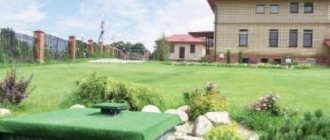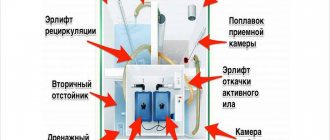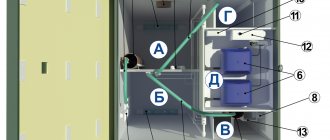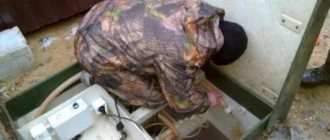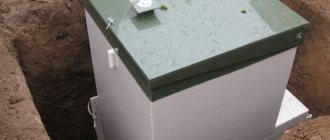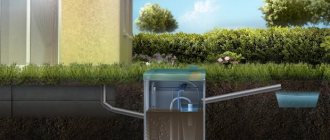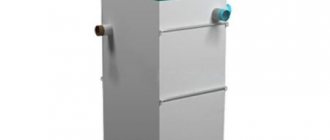Model range and modifications of autonomous sewage system Topas
TOPAS septic tanks can be equipped with one or two compressors. The first option is marked with the letter “C”, the second does not have a letter designation. The use of one compressor in TOPAS-S models reduced their cost by 10% in comparison with two-compressor analogues.
TOPAS and TOPAS-S are identical in their functions. It’s just that in models with the “C” prefix, the compressor operates continuously, and air enters the chambers through the distribution valve. And in classic models, the supply of air to the chambers of the first and second cleaning cycles is assigned to different compressors, which operate alternately.
Both Topaz and Topaz-S can be presented in modifications:
- PR – forced drainage of wastewater. For this purpose, a pump is installed in the system. Liquid discharge is carried out in any direction.
- Long - a model with an elongated body and an inlet channel.
- Us is a septic tank with a reinforced body and stiffeners.
The number in the model label indicates the approximate number of users that can be served by an autonomous sewer system.
Disadvantages and features of operation
When operated correctly, the Topas septic tank cleans drains well, and with regular maintenance it does not smell. With the right volume, it ensures a comfortable city-level existence even in the country. All this is true, but there are also disadvantages:
- Dependence on the availability of electricity.
- The need for regular maintenance (2-4 times a year, list and description of work below).
- Restriction on salvo discharge. Each Topas septic tank model can accept a certain volume of waste at a time. You cannot drain more than this volume. This can become a problem if there are a large number of guests.
- Not everything can be drained into an autonomous sewer system. Large fragments that do not pass through the drain grate are not allowed; newspapers or any insoluble fragments are not allowed to get into the drains. Disinfectants that can get there in large quantities have a very bad effect on bacteria.
- It is necessary to take care of where you will drain/dispose of the treated wastewater. They cannot be used for watering a vegetable garden or garden, only for technical needs - watering the lawn, flower bed, etc., washing the car. Another option is to install a post-treatment station and discharge it into a drainage ditch (if there is one nearby), remove the treated wastewater into a filter column or pit filled with crushed stone for further treatment and absorption into the ground.
- In seasonal homes (dachas), it is necessary to preserve the system for the winter, otherwise the bacteria will die.
So there are certain restrictions on use. However, these installations provide better results than conventional septic tanks.
Design of septic tanks Topas
Topas sewerage system is an autonomous system for processing domestic wastewater, and is designed to serve from 4 to 150 users.
VOC Topas is selected based on the number of residents and the type of bathrooms. So, for a family of 4-5 people living in a house with a shower, Topaz 4 is suitable.
But if the house has plumbing with a large discharge (bathtub, jacuzzi), then you will have to install a septic tank model 5 or 6.
The septic tank is divided into 4 chambers:
- Waste receptacle;
- Aerotank;
- Capacity for primary sedimentation of sediment;
- Reservoir for secondary sedimentation of sludge.
The following equipment is installed inside the housing:
- Wastewater supply pipe
- Large particle filter
- Airlift and main pump
- Airlift recycling
- Airlift for pumping sludge
- Airlift stabilized sludge
- Compressors (1 or 2)
- Non-degradable particle collector
- Purified water outlet
- Liquid level sensor
- Electrical cable connection box
- Switch
- Control block
- Filter
In the first chamber, the purification process is based on the sedimentation of solid particles in the wastewater. After the liquid enters the receiver, large fragments settle at the bottom, and an oily layer collects on the surface.
After the liquid level reaches the set value, the float sensor is activated. The contents of the tank flow through the pipe into the second chamber.
The filter installed in the first housing cleans the liquid from suspended particles that may enter chamber 2.
In the second compartment, the active stage of processing liquid waste occurs. The wastewater is subjected to forced treatment in two stages. First, air is supplied to the aeration tank of the Topaz autonomous sewage system. At the same time, sediment rises from the bottom and mixes with water. The bacteria in the tank break down solid particles into water, carbon dioxide and nitrates.
After the primary phase, the aeration tank is turned off, and anaerobic (without air access) decomposition of the wastewater begins. The contents of the reservoir are filtered and fed through a tube into the third chamber.
In the third tank, the final settling of the liquid occurs, after which the purified water is discharged outside, and the sediment collects at the bottom. Water is discharged by gravity or using a pump.
Technical indicators of some models of autonomous sewage system Topas are given in the table:
| Models | |||||
| Topas 4 | Topas 5 | Topaz 6 | Topas 8 | Topaz 9 | |
| Number of users | 4 | 5 | 6 | 8 | 9 |
| Productivity (m³/day) | 0,8 | 1 | 1,15 | 1,5 | 1,7 |
| One-time discharge (l) | 175 | 220 | 250 | 440 | 510 |
| Cutting depth (m) | 0,4 – 0,85 | 0,4- 0,9 | 0,4 – 0,95 | 0,4 – 0,95 | 0,4 – 0,95 |
| Depth (m) | 0,85 | 0,9 | 0,95 | 0,9 | 0,95 |
| Weight, kg) | 215 | 280 | 280 | 350 | 355 |
| Dimensions L*W*H (m) | 0,95*0,97*2,5 | 1,15*1,17*2,5 | 1,15*1,17*2,55 | 1,63*1,17*2,5 | 1,63*1,17*2,55 |
Topas refers to local treatment plants
... but people are used to calling it a septic tank, and it has a reasonable price, you can buy it here - the septic tank website.
The difference between a septic tank and a VOC is that the former require pumping and post-treatment of wastewater, and sometimes the disposal of semi-purified water. Treatment facilities perform the task of centralized sewerage; they completely purify water by 98-99% to technical condition, which can be used for domestic needs.
How the station works
- The wastewater enters the first compartment, where large debris settles and fats float to the surface
- When the level of settled water increases, the sensor is triggered and water is supplied to the second chamber.
- The second compartment is equipped with an aerator, which enriches the liquid with oxygen, which is necessary for the productive work of aerobes. Bacteria accelerate the decomposition of various types of inclusions, forming activated sludge.
- Afterwards, the wastewater, along with the sludge, flows into the settling tank, where additional purification and sedimentation of the sludge occurs.
- Then the purified water is sent to the outlet, and the sludge is pumped into the stabilizer.
Statistical characteristics of the TOPAS septic tank
+
- easy installation
- high degree of purification
- not large dimensions
- installation does not depend on soil conditions
- does not require pumping, cleaning is done independently. Excess sludge is removed in small quantities.
—
- high price
- energy dependence
- Regular maintenance is required.
This is the information that can be easily found on any website about the Topaz septic tank. Now about the facts.
Station advantages
Using the Topas biological treatment station has the following advantages:
- The service life reaches 50 years;
- The septic tank has small dimensions and occupies an area of 1 m2;
- The degree of purification of liquid waste is up to 98%;
- The tightness of the system guarantees the absence of foreign odors;
- “Topaz” septic tanks are installed in any soil;
- Almost all types of waste are processed;
- Sludge from the septic tank is used as fertilizer;
- No noise during liquid processing;
- There is no need to replenish the supply of reagents.
To install Topas sewerage, concreting a pit is required only in cases of high groundwater or sandy soil type.
Local septic tank in a “tank” version
The modern market offers more affordable and efficient sewage treatment plants. In particular, the “Tank” station compares favorably with analogues of the same type:
- three-chamber block-modular design;
- the presence of an additional filtration device;
- external ribs that prevent the structure from being squeezed out by groundwater;
- simplified installation, which does not require the obligatory arrangement of a concrete base.
These systems are unpretentious in maintenance, have excellent maintainability, and the ability to select models of different performance. In particular, the Tank 4 installation is aimed at serving one or more families with a total number of up to 10 people.
Maintenance of septic tanks Topas
Once every 1-2 weeks, it is necessary to open the station cover and visually monitor its operation, and according to the instructions in the data sheet, the manufacturer recommends:
- Once every 3-6 months (depending on the intensity of use): → clean the injectors of cycles 1 and 2; → clean the airlift pumps and the coarse fraction filter in the receiving chamber; → remove sludge sediment from the stabilizing chamber using a standard airlift pump. For Topas-15 and higher models, a fecal pump will be required, which is not included in the station kit and must be purchased separately by the customer; → remove non-recyclable waste using a stainless sieve; → flush the Topas system itself.
- Clean the compressor air filter once a year;
- Change the compressor membranes every 2 years;
- Once every 5 years, clean the bottom of the receiving chamber from mineralized sediment;
- Once every 10 years, replace the aeration elements on aerators.
Brief instructions for removing sludge using a built-in airlift pump
De-energize the station in the compressor compartment. After 20 minutes, unscrew the clamp and remove the plug on the hose of the sludge stabilizer airlift pump.
Force the station into the direct pumping phase and turn it on by raising the float switch in the receiving chamber.
Pump out about 50% of the volume of sludge stabilizer, then immediately replenish it with clean water to the original level.
Cleaning process
Multiple Topas devices work in a coordinated manner with the incoming waste stream. The cleaning process is carried out in several stages:
- When wastewater enters the chambers, aeration occurs for the development of bacteria. The latter destroy some particles so that others settle to the bottom and fat rises to the surface. For large fractions, a pipeline with holes has been created. Treated water is pumped through the pump. Large fractions remain so that the next filter has less volume to process. As a result, the first compartment copes with waste by 45-50%;
- The second compartment uses an aeration tank to lift contaminants above the water. Its pyramidal shape allows other particles to settle quickly. Pumps pump water into the third compartment that is still 20-30% cleaner than the initial level of contamination;
- The third and fourth compartments, similar to the previous one, bring the purification to 97-99%.
The water then automatically fills another container. The further fate of the liquid is technical use.
For the Topaz septic tank to operate, it must have a continuous power supply. If it occurs intermittently, then the operation of the aerator stops, the bacteria quickly die out (within 4-8 hours), which requires starting the cleaning process again.
Station operation in winter and conservation
Insulation is installed in the lid of the septic tanks. It maintains a stable temperature in the tank in mild frosts. If a residential building is located in a zone with winter air temperatures down to -20˚, insulation of the outer part of the tank is not carried out. When the air temperature drops below - 15˚, the lid of the container is not opened.
To ensure full operation of the system in frosts below 20 degrees, during installation the housing is insulated with mineral wool and expanded polystyrene.
Before buying a septic tank from the first seller you come across, we recommend getting advice from a specialist who will perform calculations and tell you which Topas model is suitable in each specific case.
The conservation of the Topas station for the winter or long period is carried out as follows:
- Pump out the contents of all chambers one by one (no more than 40% of the volume), filling with clean water to the previous level. Do this in several approaches, starting from the sludge stabilizer settling chamber→aeration tank chamber→receiving chamber, until the water is completely clarified;
- Rinse the station with water pressure from a hose;
- Clean airlifts, nozzles and pumps;
- De-energize the skeptic;
- Remove the compressor and pump (in models with forced drainage);
- Additionally, insulate the station cover with a material that does not absorb moisture (For example, a sheet of foamed polypropylene with a thickness of more than 50 mm).
Economic benefits of using Topas cleaning systems
The owners of “Topas” were convinced of the cost-effectiveness and reliability of aerating compressor devices that saturate the working solution with oxygen, as well as the quality of water purification, which in technical status can be used for household needs.
Automated control of the compressor unit contributes to optimal energy consumption. The cost of consumed electricity is compensated many times over by savings on sewerage services.
The list of positive properties can be supplemented by the almost silent operation of the compressor, the absence of characteristic odors, and the preservation of performance under significant and even extreme temperature changes.
According to experts and user reviews, Topas stations fully correspond to the quality level of their price category. The offered assortment includes a number of models of different volumes, allowing you to select a station with the necessary performance margin sufficient to process volley discharges of sewage.
Warranty terms and conditions
Attention! Make sure that the seller has completely filled out the warranty card indicating all serial numbers of the product, as well as the type of station, size, date of sale, stamp of the trading organization and signature of the responsible person or seller.
Provided that the Topas station was purchased from a legal seller and operated in accordance with the technical passport, the warranty period is 36 months from the date of its commissioning (if there is no mark on commissioning in the technical passport, the warranty period starts from the moment of installation, if there is no this mark, then from the date of sale, but not more than 48 months from the date of sale by the manufacturer). The warranty covers all defects caused by the manufacturer.
Note
: The warranty period of the control unit is 1 year if all factory seals are preserved. The warranty for pumps, compressors and other electrical equipment is regulated by the manufacturers of these products and is stated in the passport.
The warranty does not apply if:
- defects arising due to the fault of the consumer due to violations of the operating rules or installation of the installation;
- making changes to the design without agreement with the manufacturer.
What are the complaints about?
Users do not always follow the rules for using the device and throw prohibited waste into the drain. Prohibited items include:
- animal hair;
- hair;
- construction, polymer and rubber waste;
- other.
What to do if the septic tank is clogged
What disadvantages do consumers note? The septic tank copes with the treatment of wastewater flows coming from dishwashers, washing machines, and bathrooms, but the device cannot cope with liquids such as alcohol-containing solutions, chemicals and medications.
However, even with correct use, septic tank users note such disadvantages as an unpleasant odor, vaguely reminiscent of rot, from the tank and the cloudy color of the liquid at the outlet. Often there are malfunctions with the float, due to which, after the tank is overfilled, liquid begins to pour into the electrical part, because of this it is necessary to order and replace failed parts. This situation arises not only when installing a septic tank yourself, but also when installing equipment by specialists.
This is due to the cheapness of materials, incorrect installation or a simple omission when assembling the next septic tank, although more and more users of the Topas 8 septic tank device talk about the shortcomings of the model.
Helpful information. If the septic tank was ordered from an official supplier, any repairs and maintenance are provided by the organization free of charge, and equipment deficiencies are eliminated.
Popular local septic tanks of other brands
It should be noted that there has been a stable demand for wastewater treatment systems of other brands.
- In particular, compact four-chamber Kedr stations with a daily wastewater processing capacity of 1 m3 are selling well. 4 models of DSK septic tanks, with a capacity of 120 to 750 l/day, are also popular.
- “Breeze” stations have the advantage of being energy independent; “Osina” septic tanks can be used for 3-5 years without periodic cleaning of sludge deposits.
- Sewage treatment systems “Ecoline”, “Favorit”, “Leader”, “Unilos” and their analogues have similar performance characteristics, therefore they differ to a greater extent in performance and body material.
Features of system installation
Its service life and ease of further maintenance depend on how correctly the septic tank is installed. It should be noted that various septic tanks can be used under certain conditions and taking into account the type of soil, the presence and depth of underground groundwater, as well as the level of freezing of the ground.
Installation of a septic tank "TOPAS"
The device is mounted in a specially dug pit so that the upper part of the lid rises 20 centimeters above ground level. This is necessary to prevent melt water from overflowing and getting inside the installation. The lid is additionally insulated with Peneplex or Energoflex. After the installation is immersed in the pit, it is sprinkled while simultaneously filling the device with water to normalize the pressure inside and outside.
Installation of a septic tank "BioDeka"
The unit is also installed in a prepared pit on a “cushion” of sand, which prevents soil subsidence. One of the important arguments in favor of this septic tank is that it can be installed in areas with different groundwater levels. Then the equipment is insulated and immersed in the pit. This is followed by commissioning work.
Theoretically, the installation of an autonomous sewage system can be done independently, but it is still better to leave this issue to the specialists of Septic North-West [/anchor], who will complete the task in one day.
Conclusions: The process of installing septic tanks from TOPAS and BioDeka is, in principle, not much different and is carried out according to a principle similar to the principle of installing any other local treatment station. But, at the same time, BioDeka is less sensitive to groundwater levels.
Technical characteristics of installations
To compare 2 types of local sewerage, let’s take two installations of running capacity based on the number of users of 5 people, which are suitable for a summer house, private house or cottage:
| Model | BioDeca-5 C-800 | TOPAS 5 |
| Type | Biological treatment station | Biological treatment station |
| Material | polypropylene | polypropylene |
| Case shape | cylindrical | square |
| Processing volume m3/day | 1 | 1 |
| Volley discharge, liters | 250 | 220 |
| Weight, kg | 200 | 230 |
| Alarm | in stock | Additional installation equipment is possible |
| Electronics | 1 compressor | 2 compressors |
| Anti-clog protection | film degasser | film remover |
Note that the range of TOPAS models (users up to 150 people, salvo discharge 4500 liters and processing volume 24 m3/day) is wider than that of BioDek (with a maximum number of users 20 people, salvo discharge 950 liters. , and a productivity of 4 m3/day). Therefore, first you need to decide exactly what power is needed in each specific case.
How to decide which is better - “TOPAS” or “BioDeca”
As mentioned earlier, TOPAS installations of various capacities can be selected for both a private home or cottage, and for a high-rise building with a capacity of more than 100 people. Service life – 50 years. They are used both on an ongoing basis and at certain times of the year. Provided that the equipment is preserved for the time when it is not in use.
The strength of the BioDeka septic tank is the shape of the body, which allows the pressure to be evenly distributed inside and outside, as well as the lugs on the bottom. Its advantages are the possibility of installation in areas with high groundwater levels and ease of design and maintenance.
The weak point of these purification systems is their dependence on a constant supply of electricity. Interruptions in the electrical network can lead to overflow of the septic tank and insufficient operation
